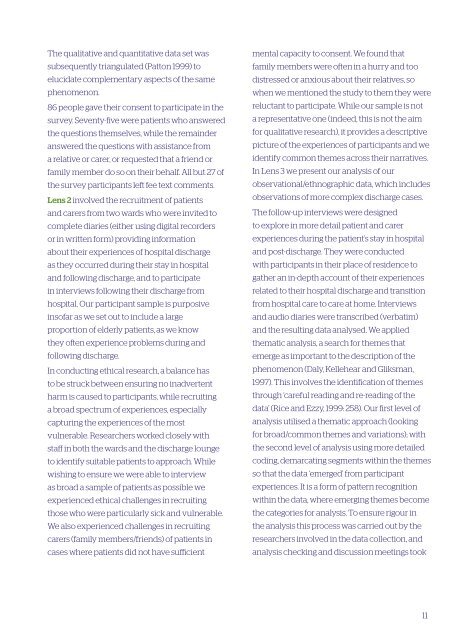Hospital Discharge
3Jzx309Yruj
3Jzx309Yruj
You also want an ePaper? Increase the reach of your titles
YUMPU automatically turns print PDFs into web optimized ePapers that Google loves.
The qualitative and quantitative data set was<br />
subsequently triangulated (Patton 1999) to<br />
elucidate complementary aspects of the same<br />
phenomenon.<br />
86 people gave their consent to participate in the<br />
survey. Seventy-five were patients who answered<br />
the questions themselves, while the remainder<br />
answered the questions with assistance from<br />
a relative or carer, or requested that a friend or<br />
family member do so on their behalf. All but 27 of<br />
the survey participants left fee text comments.<br />
Lens 2 involved the recruitment of patients<br />
and carers from two wards who were invited to<br />
complete diaries (either using digital recorders<br />
or in written form) providing information<br />
about their experiences of hospital discharge<br />
as they occurred during their stay in hospital<br />
and following discharge, and to participate<br />
in interviews following their discharge from<br />
hospital. Our participant sample is purposive<br />
insofar as we set out to include a large<br />
proportion of elderly patients, as we know<br />
they often experience problems during and<br />
following discharge.<br />
In conducting ethical research, a balance has<br />
to be struck between ensuring no inadvertent<br />
harm is caused to participants, while recruiting<br />
a broad spectrum of experiences, especially<br />
capturing the experiences of the most<br />
vulnerable. Researchers worked closely with<br />
staff in both the wards and the discharge lounge<br />
to identify suitable patients to approach. While<br />
wishing to ensure we were able to interview<br />
as broad a sample of patients as possible we<br />
experienced ethical challenges in recruiting<br />
those who were particularly sick and vulnerable.<br />
We also experienced challenges in recruiting<br />
carers (family members/friends) of patients in<br />
cases where patients did not have sufficient<br />
mental capacity to consent. We found that<br />
family members were often in a hurry and too<br />
distressed or anxious about their relatives, so<br />
when we mentioned the study to them they were<br />
reluctant to participate. While our sample is not<br />
a representative one (indeed, this is not the aim<br />
for qualitative research), it provides a descriptive<br />
picture of the experiences of participants and we<br />
identify common themes across their narratives.<br />
In Lens 3 we present our analysis of our<br />
observational/ethnographic data, which includes<br />
observations of more complex discharge cases.<br />
The follow-up interviews were designed<br />
to explore in more detail patient and carer<br />
experiences during the patient’s stay in hospital<br />
and post-discharge. They were conducted<br />
with participants in their place of residence to<br />
gather an in-depth account of their experiences<br />
related to their hospital discharge and transition<br />
from hospital care to care at home. Interviews<br />
and audio diaries were transcribed (verbatim)<br />
and the resulting data analysed. We applied<br />
thematic analysis, a search for themes that<br />
emerge as important to the description of the<br />
phenomenon (Daly, Kellehear and Gliksman,<br />
1997). This involves the identification of themes<br />
through ‘careful reading and re-reading of the<br />
data’ (Rice and Ezzy, 1999: 258). Our first level of<br />
analysis utilised a thematic approach (looking<br />
for broad/common themes and variations); with<br />
the second level of analysis using more detailed<br />
coding, demarcating segments within the themes<br />
so that the data ‘emerged’ from participant<br />
experiences. It is a form of pattern recognition<br />
within the data, where emerging themes become<br />
the categories for analysis. To ensure rigour in<br />
the analysis this process was carried out by the<br />
researchers involved in the data collection, and<br />
analysis checking and discussion meetings took<br />
11


